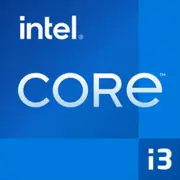Intel Core i3-4150

Intel Core i3-4150 in 2025: Is It Worth Getting This Budget “Veteran”?
Introduction
Even in 2025, ten-year-old processors like the Intel Core i3-4150 continue to find applications in budget systems. Released in 2014, this chip has become a symbol of affordable performance for office tasks and basic multimedia needs. Let’s explore whether it is still relevant today and who might benefit from it.
Main Specifications: Modest but Practical
Architecture and Process Technology
The Core i3-4150 is based on the Haswell architecture (4th generation Intel Core) with a 22 nm process technology. It was the first mass-market platform to support AVX2 instructions, which enhance performance in floating-point calculations. However, by 2025, 22 nm seems outdated compared to modern 7 nm and 5 nm chips.
Performance
- Cores and Threads: 2 cores / 4 threads thanks to Hyper-Threading.
- Frequency: 3.5 GHz (no Turbo Boost).
- Cache: 3 MB L3.
- Graphics: Intel HD 4400 (basic performance, supports DirectX 11).
- Geekbench 6: 1004 (single-core), 1890 (multi-core). For comparison, a modern budget Intel Core i3-12100 scores around 2000/6000 points.
Key Features
- Energy efficiency (TDP 54 W).
- Integrated graphics for operation without a discrete video card.
- Virtualization support (VT-x).
Compatible Motherboards: Hunting for Rarities
Socket and Chipsets
This processor uses the outdated LGA 1150 socket. Compatible chipsets:
- H81, B85 — budget options with basic features.
- H87, Z87 — RAID support, more SATA/USB 3.0 ports.
Selection Tips
- New Boards: In 2025, new motherboards for LGA 1150 are no longer produced. Remaining stock is priced from $80 (e.g., ASUS H81M-K), but they are more commonly found on the second-hand market ($30-50).
- Advice:
- Check the condition of capacitors and the socket.
- Look for models with HDMI/DVI for easy connectivity.
- Ensure USB 3.0 and SATA III are available if planning to use an SSD.
Memory Support: Only DDR3
The Core i3-4150 works only with DDR3 (up to 32 GB, 2 channels, frequency up to 1600 MHz).
- Recommendations:
- For Windows 10/11, 8 GB (2×4 GB) is sufficient.
- Use modules with low timings (e.g., 9-9-9-24) for a slight performance boost.
- Limitations: DDR3 is slower than modern DDR4/DDR5, impacting performance in resource-intensive applications.
Power Supply: Minimum Cost
With a TDP of 54 W, the processor does not require a powerful PSU:
- Without a discrete video card: A 300 W power supply is sufficient (e.g., be quiet! System Power 10 300W, $40).
- With a video card: For a GTX 1650 (TDP 75 W), a 450 W PSU is needed (Corsair CX450, $60).
- Important: Choose models with an 80 Plus Bronze certification and overload protection.
Pros and Cons: Who Is It Suitable For?
Pros
- Low power consumption and heat generation.
- Quiet operation even with the stock cooler.
- Ability to build a system from spare parts.
Cons
- Only 2 physical cores — struggles with multi-threaded tasks (rendering, streaming).
- No support for NVMe, USB 3.1, Wi-Fi 6.
- Limited upgrade potential: the maximum for LGA 1150 is the Core i7-4790K.
Use Cases: Where Is the Power Sufficient?
1. Office and Study:
- Document work, browsing (10+ tabs), Zoom.
- Example: a build with 8 GB DDR3, 240 GB SSD — launching Windows 11 (via third-party patches).
2. Multimedia:
- 4K video playback (with hardware decoding via HD 4400).
- Music, streaming services.
3. Light Gaming:
- Dota 2 (720p, medium settings — 40-50 FPS).
- Minecraft (without shaders — 60 FPS).
4. Home Server/NAS:
- Low power consumption makes it suitable for 24/7 operation.
Comparison with Competitors: What to Choose Instead?
1. AMD Athlon X4 860K (2014):
- 4 cores but lacks Hyper-Threading.
- Falls behind in single-thread performance (Geekbench 6: ~800 points).
2. Intel Pentium G4560 (2017):
- 2 cores / 4 threads but based on the Kaby Lake architecture (14 nm).
- Better optimized for Windows 11.
3. Modern Analogues (2025):
- AMD Ryzen 3 7300X ($120): 4 cores / 8 threads, DDR5, integrated RDNA 2 graphics.
- Intel Core i3-14100 ($130): 4 cores / 8 threads, supports PCIe 5.0.
Assembly Tips: How to Avoid Mistakes
1. SSD is Essential: Even a SATA SSD (Crucial MX500, $35/500 GB) will speed up the system by 3-4 times.
2. Don't Overpay for the Motherboard: A used board for $30 is the optimal choice.
3. Cooling: The stock cooler is adequate, but for quiet operation, consider the DeepCool GAMMAXX 400 ($20).
4. Upgrade: Add a GTX 1650-level graphics card ($150) for gaming.
5. Check RAM: Use MemTest86 to test used memory.
Final Conclusion: Who Is the i3-4150 Suitable For?
This processor should be considered only in two cases:
1. Ultra-Budget Build: If you need to build a PC for $150-200 for basic tasks.
2. Upgrading an Old PC: Replacing weaker Pentium or Celeron processors on LGA 1150.
Alternative: For $250-300, you can build a system on AMD Ryzen 5 5500 (6 cores) with support for DDR4 and NVMe, which will be more beneficial in the long run.
Final Thoughts: The Intel Core i3-4150 in 2025 is a choice for enthusiasts nostalgic for Haswell or those who need a “work tool” here and now. For most users, modern budget CPUs offer better performance for the same price.
Basic
CPU Specifications
Memory Specifications
GPU Specifications
Benchmarks
Compared to Other CPU
Share in social media
Or Link To Us
<a href="https://cputronic.com/index.php/cpu/intel-core-i3-4150" target="_blank">Intel Core i3-4150</a>